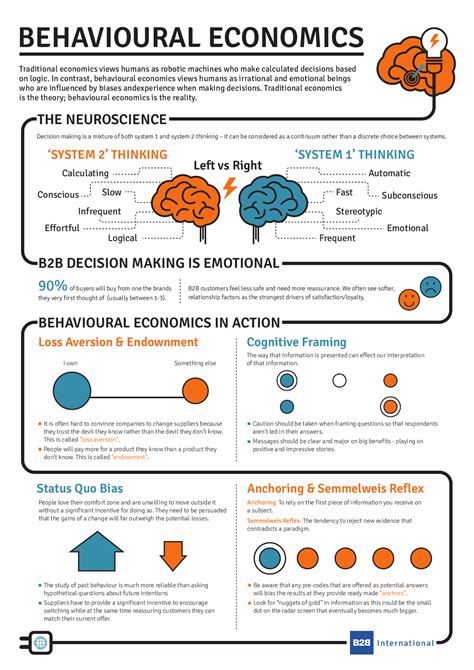In the world of economics and decision making, there is a fascinating field that delves into the intricate workings of the human mind: behavioral economics. It combines the principles of psychology with economics to understand how people make choices and decisions. This blog post will explore the psychology of decision making through the lens of behavioral economics, shedding light on the various factors that influence our choices. From cognitive biases and emotional influences to social influence and the paradox of choice, we will uncover the underlying mechanisms that drive human behavior. By understanding these concepts, we can gain valuable insights into our own decision-making processes and even learn how to nudge ourselves and others towards better choices. Join us on this journey as we unravel the science behind decision making and gain a deeper understanding of the human psyche.
Table of Contents
The Role of Psychology in Decision Making
Psychology plays a crucial role in understanding how individuals make decisions. One of the key concepts in psychology that influences decision-making is the study of cognitive biases. These biases are the systematic patterns of deviation from norm or rationality in judgment, and they often lead to irrational decision-making. Understanding these biases is essential in order to make better decisions.
Another important aspect of psychology in decision-making is the influence of emotions. Emotions can significantly impact the choices we make, often leading to impulsive or irrational decisions. Recognizing the role of emotions in decision-making can help individuals develop strategies to make more rational choices.
Additionally, psychology also explores the concept of prospect theory, which suggests that individuals make decisions based on the potential value of losses and gains rather than the final outcome. This theory has significant implications for understanding how people evaluate risks and make decisions under uncertainty.
Lastly, psychology highlights the role of social influence in decision-making. People are often influenced by the opinions and actions of others, leading to conformity and groupthink. Understanding the impact of social influence can help individuals make more independent and informed decisions.
Understanding the Basics of Behavioral Economics
Behavioral economics merges psychology with economics to understand and explain why people make irrational decisions. This field of study is built on the premise that people do not always act rationally when making choices, and that their decisions are influenced by various psychological and social factors.
One of the key concepts in behavioral economics is the idea that individuals often have limited willpower and are prone to making decisions based on emotions and social influences. Traditional economic models assume that people always act in their best interests, but in reality, our decisions are often swayed by biases and cognitive shortcuts.
Behavioral economics also explores how individuals value and perceive different options, and how their decision-making processes are impacted by framing and the way options are presented to them. This highlights the importance of understanding the role of psychology in shaping economic behavior.
Overall, gaining a fundamental understanding of behavioral economics is crucial in order to comprehend the intricacies of decision making and how individuals deviate from the rationality assumed in traditional economic theories.
Cognitive Biases and their Influence on Decision Making
When it comes to decision-making, our cognitive biases play a significant role in influencing the choices we make. These biases are the result of our brain’s attempt to simplify information processing and make decisions quickly. However, they can often lead us to make irrational choices without even realizing it.
One of the most common cognitive biases is the confirmation bias, where we tend to seek out information that confirms our existing beliefs and ignore evidence that contradicts them. This can lead to poor decision-making because we are not considering all the available information objectively.
Another prevalent cognitive bias is the availability heuristic, where we base our decisions on the information that is readily available to us, rather than considering all relevant factors. This can lead to an overemphasis on recent events or vivid memories, skewing our perception of reality.
Furthermore, the sunk cost fallacy is a cognitive bias that causes us to continue investing in a certain course of action because we have already invested time, money, or effort into it, even if it is not the best decision moving forward. This can prevent us from making rational choices based on the current situation.
The Impact of Emotions on Decision Making
Emotions play a crucial role in the decision-making process, often influencing the choices we make in both personal and professional contexts. When we are faced with a decision, our emotions can guide us, leading us to make choices that may not align with logical reasoning. Strong emotions such as fear, anger, or excitement can cloud our judgment and impact the outcome of our decisions.
Furthermore, emotions can also influence our risk tolerance and willingness to take chances. For example, feelings of overconfidence can lead individuals to take risks they might not otherwise consider, while fear can lead to avoidance of opportunities that could be beneficial. The impact of these emotional responses on decision making is significant, as it can ultimately determine the course of action taken in any given situation.
Recognizing the influence of emotions on decision making is essential for individuals seeking to make informed choices. By understanding their own emotional responses and implementing strategies to manage them effectively, individuals can make more rational decisions that are not solely driven by fleeting feelings. Additionally, considering the emotional impact of decisions on others is important in fields such as leadership, negotiation, and conflict resolution, as it can help foster empathy and understanding in interpersonal relationships.
In conclusion, the impact of emotions on decision making cannot be understated. It is essential to recognize the power of emotions in shaping our choices and to develop the necessary skills to navigate these emotional influences effectively. By doing so, individuals can make more informed and balanced decisions that consider both rationality and emotional intelligence.
Understanding the Concept of Prospect Theory
Prospect theory is a psychological theory that helps to explain the decision-making process of individuals when faced with uncertainty. It was first introduced by Daniel Kahneman and Amos Tversky in 1979 and has since become an influential concept in the field of behavioral economics.
According to prospect theory, individuals tend to make decisions based on the potential value of losses and gains rather than the final outcome. This means that people are more likely to take risks to avoid losses, even if the potential gains are minimal. This is known as loss aversion and has a significant impact on how people make decisions in various situations.
Another key concept of prospect theory is the notion of diminishing sensitivity, which suggests that the impact of losses and gains diminishes as the magnitude of the outcome increases. In other words, the difference between a $50 and $100 gain is perceived as greater than the difference between a $10,000 and $10,050 gain, despite both being a $50 difference.
Understanding the concept of prospect theory can provide valuable insights into human decision-making processes and help individuals and businesses make more informed choices. By recognizing the influence of cognitive biases and emotional factors on decision making, it is possible to implement strategies that take these elements into account and improve the overall decision-making process.
The Role of Social Influence in Decision Making
Have you ever noticed how your decisions are influenced by the people around you? Social influence plays a significant role in our decision-making processes, whether we realize it or not. From the products we buy to the opinions we hold, our choices are often shaped by the behavior and attitudes of those in our social circles.
One way social influence impacts decision making is through conformity. As social beings, we have a natural tendency to align our beliefs and actions with those of the people around us. This can lead to us making choices based on what is popular or accepted by our peers, even if it may not align with our true preferences.
Another aspect of social influence is the concept of social proof. When we see others endorsing a particular decision or product, it can validate our own choices and make us more likely to follow suit. Whether it’s a restaurant with a long line or a product with rave reviews, social proof can sway our decisions in a way we may not even realize.
Furthermore, social influence can also come in the form of authority figures or opinion leaders. When we look to experts or influential individuals for guidance, their opinions can heavily impact our decision-making process. Whether it’s a celebrity endorsing a product or a trusted figure offering advice, their influence can shape our choices in significant ways.
Nudging: A Powerful Behavioral Economics Tool
Nudging is a concept in behavioral economics that has gained significant attention in recent years. It involves influencing people’s behavior and decision making without restricting their options or changing their incentives. This method operates on the principle that small changes in the way choices are presented can have a substantial impact on the decisions individuals make. Whether it’s encouraging people to save more for retirement, choose healthier food options, or opt for environmentally friendly products, nudging has proven to be an effective tool in steering individuals towards better choices.
One of the key aspects of nudging is its subtle nature. Rather than imposing strict regulations or outright bans, nudges work by framing choices in a way that makes the desired option more appealing or convenient. For example, placing healthier snacks at eye level in a cafeteria or redesigning the layout of a grocery store to make fruits and vegetables more prominent are both forms of nudging. By making the preferred option more visible and accessible, individuals are more likely to choose it without feeling coerced or restricted.
Furthermore, nudging is based on the understanding that individuals often rely on mental shortcuts or heuristic strategies when making decisions. These cognitive biases can lead to suboptimal choices, and nudges aim to counteract these biases by gently guiding individuals towards more rational decisions. By leveraging insights from psychology and behavioral economics, nudging has enabled policymakers, businesses, and organizations to influence behavior in a way that is both ethical and effective.
It’s important to note that while nudging can be a powerful tool for promoting positive behavior change, it also raises ethical and moral concerns. Critics argue that nudges can be manipulative and infringe on individual autonomy, especially when used by governments or corporations. As such, the responsible and transparent use of nudging techniques is essential to ensure that they serve the interests of individuals and society as a whole.
The Paradox of Choice: How it Affects Decision Making
When faced with an abundance of options, the paradox of choice can have a significant impact on our decision-making process. The concept suggests that while having more choices may seem beneficial, it can actually lead to greater anxiety, dissatisfaction, and even paralysis when trying to make a decision.
This paradox can be observed in various aspects of life, from consumer products to career choices. For example, when shopping for a new phone, the vast array of models, brands, and features can make it incredibly challenging to make a decision. Similarly, when considering different career paths, the fear of making the wrong choice among numerous options can be overwhelming.
The paradox of choice can also affect the way we approach relationships and lifestyle decisions. In the age of online dating, the endless options can make it difficult to commit to one person, as the fear of missing out on a better match lingers. Moreover, when making lifestyle choices, such as where to live or what hobbies to pursue, the multitude of options can lead to heightened stress and dissatisfaction.
In understanding how the paradox of choice affects decision-making, it is essential to recognize the role of conditioning and expectations. Society often convinces us that having more options equates to greater freedom and happiness. However, as research has shown, an abundance of choices can lead to decision fatigue and regret, impacting our overall well-being.
The Role of Framing in Decision Making
Understanding the concept of framing in decision making is essential for anyone who wants to make informed choices. Framing refers to the way information is presented, which can greatly influence the decisions people make. This can include the context in which the information is given, the wording of the information, and the overall presentation. Research has shown that the way information is framed can have a significant impact on the choices people make.
For example, presenting the same information in a positive light as opposed to a negative one can lead to different decisions. This is known as positive framing and negative framing, and the way the information is presented can lead to a bias in decision making. In addition, the emotional content of the framing can also play a role, as emotions can heavily influence decision making. The way information is framed can trigger different emotional responses, which can ultimately impact the choices a person makes.
Understanding the role of framing is crucial for individuals and businesses alike. By being aware of how information is presented and how it can influence decision making, people can make more informed choices. Furthermore, businesses can utilize framing to influence consumer choices, whether it’s through advertising, product packaging, or marketing strategies. By understanding the impact of framing, businesses can tailor their messaging to influence consumer decisions in a more effective way.
In conclusion, the role of framing in decision making cannot be overstated. The way information is presented can have a profound impact on the choices people make. By being aware of the influence of framing, individuals can make more informed decisions, and businesses can utilize framing to influence consumer choices. It’s essential to understand the power of framing in order to make more strategic and rational decisions.
Predictably Irrational: The Science behind Decision Making
When it comes to decision making, human behavior often deviates from traditional economic theory. This phenomenon is at the core of Predictably Irrational, a concept that explores the science behind why people make seemingly irrational decisions. Through extensive research and real-life examples, it has become clear that our decisions are influenced by a variety of psychological and emotional factors, leading us to make choices that defy logical reasoning.
One of the key components of predictably irrational behavior is the concept of cognitive biases. These biases, such as confirmation bias and anchoring bias, cause individuals to make decisions based on faulty reasoning or incomplete information. Understanding the impact of cognitive biases is crucial in comprehending the science behind decision making, as it sheds light on why people often make choices that are not in their best interest.
Moreover, the role of emotions in decision making cannot be overlooked. Our emotional state has a significant influence on the decisions we make, sometimes leading us to prioritize short-term satisfaction over long-term benefits. By delving into the science of how emotions shape our choices, we gain valuable insights into the predictably irrational nature of decision making.
Overall, Predictably Irrational uncovers the intricate web of factors that contribute to the seemingly irrational decisions humans make. By exploring the science behind decision making, we can gain a deeper understanding of our behavior and the underlying mechanisms that drive our choices.





